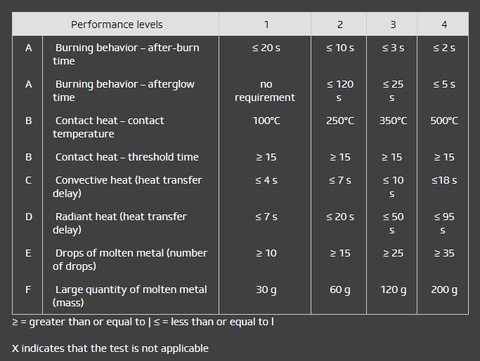
Hand protection against thermal risks such as heat or fire.
EN 407 specifies the requirements, test methods, information to be supplied, and marking for gloves that provide protection against heat and/or fire.
EN 407 GLOVES PROVIDING PROTECTION AGAINST THERMAL RISKS (HEAT AND/OR FIRE)
EN 407:2004 specifies the requirements, test methods, information to be supplied, and marking for gloves that provide protection against heat and/or fire. This should be used for gloves that protect the hands against heat and/or flames in one or more of the following forms: fire, contact heat, convective heat, radiant heat, small splashes, and large quantities of molten metal. This standard is applicable only in conjunction with EN420. Product tests may indicate performance levels but not protection levels.
The nature and degree of protection are shown by a pictogram followed by a series of six performance levels that relate to specific protective qualities. The higher the number, the better the test result. The following product features are those tested relative to the specifications of this standard:
A: Resistance to flammability (performance level 0-4)
The glove’s material is stretched and lit with a gas flame. The flame is held against the material for 15 seconds. After the flame is distinguished, the time that the material glows or burns is measured.
B: Resistance to contact heat (performance level 0-4)
The glove’s material is exposed to temperatures between 100°C and 500°C to determine the amount of time required for the material on the inside of the glove to increase by 10°C from the starting temperature (approx. 25°C). 15 seconds is the minimum accepted length of time for approval. For example: to be marked with class 2, the glove inner material must withstand 250°C heat for 15 seconds before the material exceeds 35°C.
C: Resistance to convective heat (performance level 0-4)
The glove is placed in contact with a gas flame (80Kw/kvm) to determine the amount of time required to increase the temperature of a glove inner material by 24°C.
A score is indicated only if the sample obtains a performance level of 3 or 4 on the flammability test.
D: Resistance to radiant heat (performance level 0-4)
The glove’s material is stretched in front of a heat source with an effect of 20-40 kw/kvm to measure the average time for 2.5 kw/kvm of heat penetration.
A score is indicated only if the sample obtains a performance level of 3 or 4 on the flammability test.
E: Resistance to small splashes of molten metal (performance level 0-4)
This test is used to determine the number of drops of molten metal that will increase the temperature between the inside of the glove and the wearer’s skin by 40°C.
A score is indicated only if the sample obtains a performance level of 3 or 4 on the flammability test.
F: Resistance to large splashes of molten metal (performance level 0-4)
After the simulated skin is affixed to the inside of the sample glove. Molten metal is then poured over the glove to determine what quantity will damage the simulated skin. If molten metal droplets remain stuck to the glove or if the glove ignites, the sample glove will receive a score of 0.
